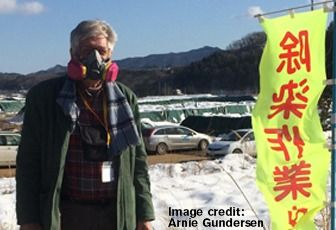Is solar power in nuclear disaster exclusion zones advisable?
By Arnold Gundersen | September 8, 2016

A July 2016 article in The Guardian said that the country of Ukraine has been soliciting funds for a proposed project to turn extensive swathes of ground adjacent to Chernobyl into a gigantic solar collector full of photovoltaic panels. The story’s author, John Vidal, wrote: “In a presentation sent to major banks and seen by the Guardian 6,000 hectares of ‘idle’ land in Chernobyl’s 1,000 square km exclusion zone, which is considered too dangerous for people to live in or farm, could be turned to solar, biogas and heat and power generation.”
This Ukrainian proposed solar array would cover approximately 23 square miles of the 386 square-mile exclusion zone. Put in perspective, the electric output from this solar facility would yield approximately the same amount of electricity that the now-shuttered Chernobyl reactor #4 produced before it exploded. And it seems that Ukraine is not the only country with such plans; only 20 miles away from Chernobyl, another solar plant is currently under construction in the country of Belarus, in an area that was also extensively contaminated by Chernobyl’s fallout.
Similarly, land near Fukushima, Japan, is seeing solar panels sprout up near that country’s stricken nuclear power plant. It seems that there is a trend underway, in widely scattered parts of the world, that have atomic power disasters in common. But is it really advisable to have solar generating facilities in the exclusion zones created by a nuclear catastrophe? On the face of it, this would seem to be a benign, innovative use of contaminated land. But are there hazards slipping in under the radar, from seemingly innocuous sources—such as radioactive dust? And looking at the situation more broadly, is the endeavor indicative of society being far too casual about the effects of serious radioactive releases from nuclear power plants?
First, some background. There is no doubt that the electric power is needed. Because Ukraine has 15 atomic reactors, generating almost 56 percent of its total electricity—of which seven will reach the end of their licensed operating life by 2020—this proposal is not merely an academic argument. It has real economic, environmental, and health implications for the entire country. Ukraine needs a massive financial investment in new sources of electric generation to keep its lights on. While reconditioning its aging atomic reactors is possible to briefly extend their service time, the cost to recondition such aged nuclear plants is exceptionally high, exceeding several billion US dollars.
Consequently, any proposal to generate electricity and make up for the loss of generating power caused by the disaster at the nuclear power plant should be taken seriously. And the same is true of the situation in Japan.
While traveling in Fukushima Prefecture in February and March of 2016, I noticed numerous, small-scale solar installations throughout areas where habitation is either still forbidden or relocation has only recently been allowed. While not producing anywhere near the power of the proposed Ukrainian solar farm, these collectors have all been constructed following Japan’s nuclear power disaster. During my visit, I spent one month taking radiation measurements, meeting with scientific colleagues, nuclear engineers, community leaders, elected officials, doctors, and refugees evacuated and displaced by the Tokyo Electric Power Company (TEPCO) Fukushima Daiichi meltdowns.
These new solar arrays in Japan clearly show that solar power has become economically attractive, but why would Ukraine, Belarus, and Japan each choose a radiologically contaminated disaster zone for their location? Some advantages are obvious: The cost of industrial-scale solar has plummeted, making it more economical than nuclear power; electric transmission facilities are already located near the destroyed reactors, so electricity generated by solar power would have immediate access to electric grids and transmission lines; sunlight is reasonably plentiful; and there would be little public opposition in these zones, for the simple reason that there is no longer any public living in the vicinity.
But do these advantages suggest that the proposed solar farms are really viable? Or are the arrays being installed for another purpose? The Ukrainian presentation to investment banks seems to suggest that the Ukrainian government thinks that public relations is as important as economics. As their prospectus noted: “There has been a change in the perception of the exclusion zone in Ukraine. Thirty years after the Chernobyl tragedy [it] reveals opportunities for development.”
My own experience near solar arrays in Fukushima Prefecture indicates that the problems of building and maintaining solar installations in a contaminated nuclear wasteland are over-simplified, and worse, totally ignored. One of the greatest burdens of maintaining operating atomic reactors is the cost of working in a Radiologically Controlled Area. (The Lawrence Berkeley National Laboratory defines a Radiologically Controlled Area as: “Any area to which access is managed to protect individuals from exposure to radiation or radioactive materials. Individuals who enter Controlled Areas without entering Radiological Areas are not expected to receive a total effective dose equivalent of more than 0.1 rem (0.001 Sievert) in a year.”) Each nuclear power plant operates with specific instructions and constraints, with Radiation Work Permits tailored for each specific maintenance activity. Because special clothing, special respiratory equipment, and special radiation monitoring equipment are routinely required to perform even minimum maintenance activities inside a nuclear power plant, every activity takes longer, costs more, and requires more people inside each reactor than necessary in any other industrial setting.
Consequently, the question becomes: Does building solar panels on land contaminated with nuclear waste resemble work in a normal industrial setting, or is it more similar to work inside a radiologically contaminated atomic reactor—at significantly higher cost?
My take on it. From the data I gathered on my recent trip to Fukushima Prefecture, solar collectors often accumulate airborne dusts, to the point that dust sometimes reduces the overall efficiency of a photovoltaic panel. A group of scientific colleagues and I took measurements and collected dust samples on the ground immediately under and adjacent to the newly installed solar collectors in locations throughout the prefecture.
Our dust samples, tested at Worcester Polytechnic Institute in Massachusetts, found significant levels of radioactive cesium near every one of these new, post-Fukushima disaster solar collectors. Radiation levels in this dust were so high that, had they been found inside a nuclear power plant, the contaminated area would be classified as a Radiologically Controlled Area and would require a special Radiation Work Permit to enter.
As a result, this means that worker exposure from internal dust inhalation would be significantly higher at solar power arrays near or in both the Chernobyl and Fukushima Daiichi contaminated zones.
This is a significant finding, as at the moment the attitude seems to be that working in these areas is no different from working at a solar energy facility anywhere else. Instead of treating the contaminated grounds like an atomic reactor site, workers wear everyday industrial clothing to perform maintenance (and save the company significant costs in the process). I witnessed TEPCO personnel wearing paper surgical facemasks that remove only 30 percent of the radioactive dust at most. Such masks do little; the US Defense Nuclear Agency has said “It is doubtful that the use of the [paper] surgical mask served more than a psychological barrier.” The University of South Florida seems to agree, saying “…workers may experience a false sense of security when wearing [paper] surgical masks.”
During my expeditions in Fukushima Prefecture, I chose to wear an industrial-grade particulate respirator, with a 99.9 percent removal efficiency. Wearing it was uncomfortable, but after just six hours of use, the mask’s double filters each had captured 17 disintegrations per second of radioactive cesium as measured later at Worcester Polytechnic Institute. My lungs would have been contaminated with that cesium if I had only worn a surgical paper mask. Apparently, TEPCO has chosen not to protect these workers; however, we would hope that the Ukrainian government would make human health a priority, considering that it said in its presentation to banking institutions that “A special industrial area is to be created in compliance with all rules and regulations of radiation safety within the exclusion zone.” Exactly what radiation protection measures will be used by the Ukrainian government to build this solar equipment is not stated.
All solar collectors have known issues with dust buildup on their panels. If the accumulation of radioactive dust near a newly installed solar facility in Fukushima Prefecture—only five years after the meltdown—is so significant that protective clothing and respirators are required for routine maintenance, then the cost of building solar power systems in radiologically contaminated areas may prove prohibitive.
These measurements may affect how the investment community views the prospects for any form of industrialization near damaged regions around meltdowns—not to mention the long-term health implications and costs for Japanese and Ukrainian solar workers (and their families) in these contaminated areas.
Together, we make the world safer.
The Bulletin elevates expert voices above the noise. But as an independent nonprofit organization, our operations depend on the support of readers like you. Help us continue to deliver quality journalism that holds leaders accountable. Your support of our work at any level is important. In return, we promise our coverage will be understandable, influential, vigilant, solution-oriented, and fair-minded. Together we can make a difference.
Topics: Nuclear Energy, Opinion














